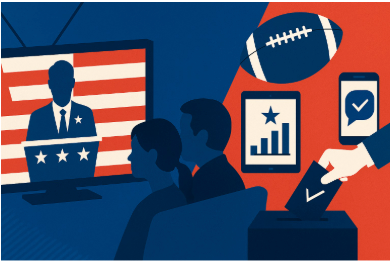📺 Screens, Sports & Strategy: Media Must-Knows for the 2026 Cycle
It’s time to rethink what you thought you knew about voter outreach. In a lively conversation among top media strategists Shannon Chatlos (Strategic Partners & Media), Danny Laub (Poolhouse), and Casey Bessette (Sage Media Planning & Placement), a clear message emerged: fragmentation, fatigue, and flexibility are defining the new media battlefield for political campaigns.
💥 Surprise! There Weren’t Many
Laub put it bluntly: “The biggest surprise is how little surprises there were” in the 2024 general election. The rise of CTV and decline of cable continued as expected—but on the Democratic side, things weren’t so stable.
Bessette observed, “Democrats were not really raising any money before mid-July and August… a lot of campaigns really didn’t start spending as early as I thought they would.” This compressed timeline led to strategic stumbles and demographic misfires, particularly with voters of color and young men. “We took certain demographics for granted,” she said.
🧠 Smarter Spending for Smaller Budgets
When budgets are tight, strategy is everything. Danny shared a case study from Ohio’s 13th congressional race where they leaned heavily on live sports—a gamble that nearly flipped the district. “We pushed all our chips into a gamble on the live sports side… and we almost won the race.”
His reasoning? “What’s the last ad you remember seeing that wasn’t during a live sports match?” In a fragmented media world, live sports are one of the last places with a captive audience.
📊 Local is the New National
Bessette reminded consultants that while national narratives matter, media strategy must remain hyper-local: “It’s less about how big the campaign is and more about who your targets are… all politics is local.” Whether you’re buying broadcast in Iowa or streaming in NYC, the key is flexibility—and an obsession with voter behavior.
Laub echoed this: “You have to do the cheapest stuff first… programmatic buys give you the precision needed when budgets are tight.”
🧠 Data & Diversity: Must-Haves, Not Nice-to-Haves
Both panelists agreed: quality data and in-house modeling are the backbone of a modern media plan. But don’t forget the human side: building strong relationships with data vendors allows campaigns to pivot rapidly when the map shifts.
As for overlooked tactics? Spanish-language radio and minority media buys came up as underutilized tools, especially critical when targeting Hispanic voters. “Radio is completely underutilized… especially in Republican primaries,” said Laub.
📈 Beyond Impressions: What Counts as Success?
Forget vanity metrics. Real success is about message penetration, mid-campaign pivots, and relentless testing. “It’s the feedback loop… the importance of creative… and being humble enough to change when it’s not working,” Laub emphasized.
🧩 Final Word: Integrated or Bust
Perhaps the sharpest insight of the hour? Alignment across creative, digital, TV, and mail is non-negotiable. “One of the biggest signs of a bad campaign is when TV, digital, and mail don’t look the same,” Laub warned.
🧠 The bottom line for 2026: Start early. Customize everything. Test relentlessly. And if you’re cutting media plans, maybe don’t cut radio first. Want to reach voters? Be where they are. And increasingly, that means a screen (or three), a podcast, and a football game.
AAPC members can watch the full webinar recording here. Not a member? Join the largest community of political and public affairs professionals today.

